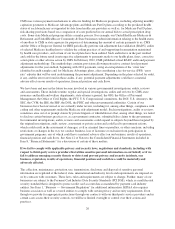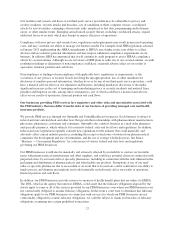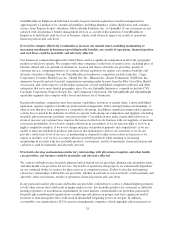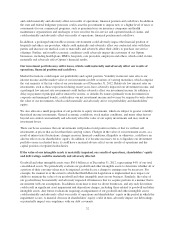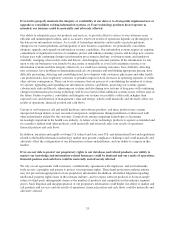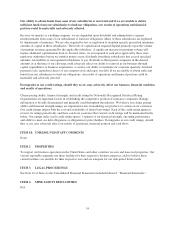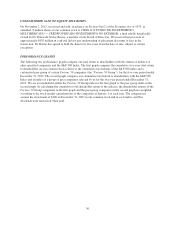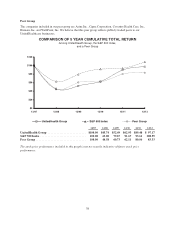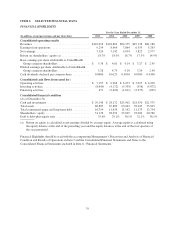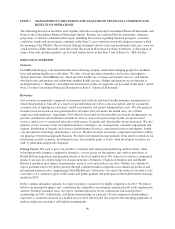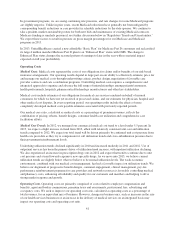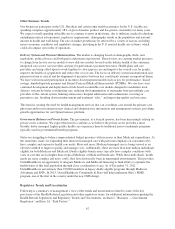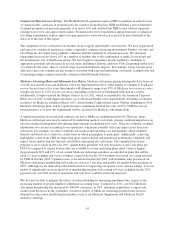United Healthcare 2012 Annual Report Download - page 35
Download and view the complete annual report
Please find page 35 of the 2012 United Healthcare annual report below. You can navigate through the pages in the report by either clicking on the pages listed below, or by using the keyword search tool below to find specific information within the annual report.If we fail to properly maintain the integrity or availability of our data or to strategically implement new or
upgrade or consolidate existing information systems, or if our technology products do not operate as
intended, our business could be materially and adversely affected.
Our ability to adequately price our products and services, to provide effective service to our customers in an
efficient and uninterrupted fashion, and to accurately report our results of operations depends on the integrity of
the data in our information systems. As a result of technology initiatives and recently enacted regulations,
changes in our system platforms and integration of new business acquisitions, we periodically consolidate,
integrate, upgrade and expand our information systems capabilities. Our information systems require an ongoing
commitment of significant resources to maintain, protect and enhance existing systems and develop new systems
to keep pace with continuing changes in information processing technology, evolving systems and regulatory
standards, emerging cybersecurity risks and threats, and changing customer patterns. If the information we rely
upon to run our businesses was found to be inaccurate or unreliable or if we fail to maintain or protect our
information systems and data integrity effectively, we could lose existing customers, have difficulty attracting
new customers, have problems in determining medical cost estimates and establishing appropriate pricing, have
difficulty preventing, detecting and controlling fraud, have disputes with customers, physicians and other health
care professionals, have regulatory sanctions or penalties imposed, have increases in operating expenses or suffer
other adverse consequences. There can be no assurance that our process of consolidating the number of systems
we operate, upgrading and expanding our information systems capabilities, protecting our systems against
cybersecurity risks and threats, enhancing our systems and developing new systems to keep pace with continuing
changes in information processing technology will be successful or that additional systems issues will not arise in
the future. Failure to protect, consolidate and integrate our systems successfully could result in higher than
expected costs and diversion of management’s time and energy, which could materially and adversely affect our
results of operations, financial position and cash flows.
Certain of our businesses sell and install hardware and software products, and these products may contain
unexpected design defects or may encounter unexpected complications during installation or when used with
other technologies utilized by the customer. Connectivity among competing technologies is becoming
increasingly important in the health care industry. A failure of our technology products to operate as intended and
in a seamless fashion with other products could materially and adversely affect our results of operations,
financial position and cash flows.
In addition, uncertain and rapidly evolving U.S. federal and state, non-U.S. and international laws and regulations
related to the health information technology market may present compliance challenges and could materially and
adversely affect the configuration of our information systems and platforms, and our ability to compete in this
market.
If we are not able to protect our proprietary rights to our databases and related products, our ability to
market our knowledge and information-related businesses could be hindered and our results of operations,
financial position and cash flows could be materially and adversely affected.
We rely on our agreements with customers, confidentiality agreements with employees, and our trademarks,
trade secrets, copyrights and patents to protect our proprietary rights. These legal protections and precautions
may not prevent misappropriation of our proprietary information. In addition, substantial litigation regarding
intellectual property rights exists in the software industry, and we expect software products to be increasingly
subject to third-party infringement claims as the number of products and competitors in this industry segment
grows. Such litigation and misappropriation of our proprietary information could hinder our ability to market and
sell products and services and our results of operations, financial position and cash flows could be materially and
adversely affected.
33





